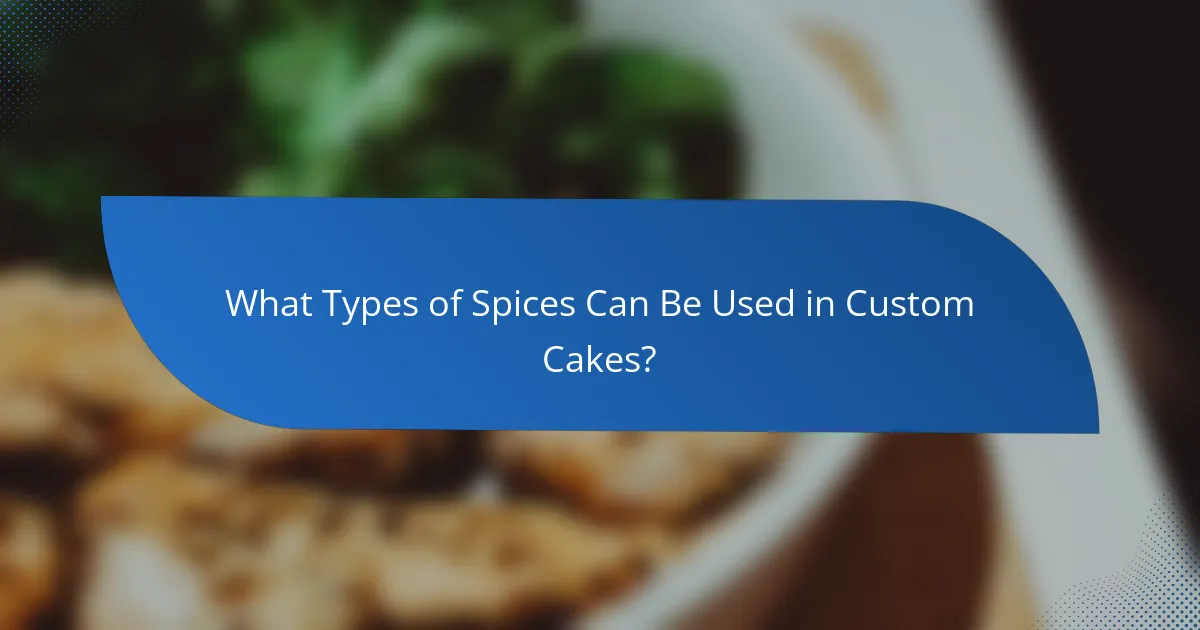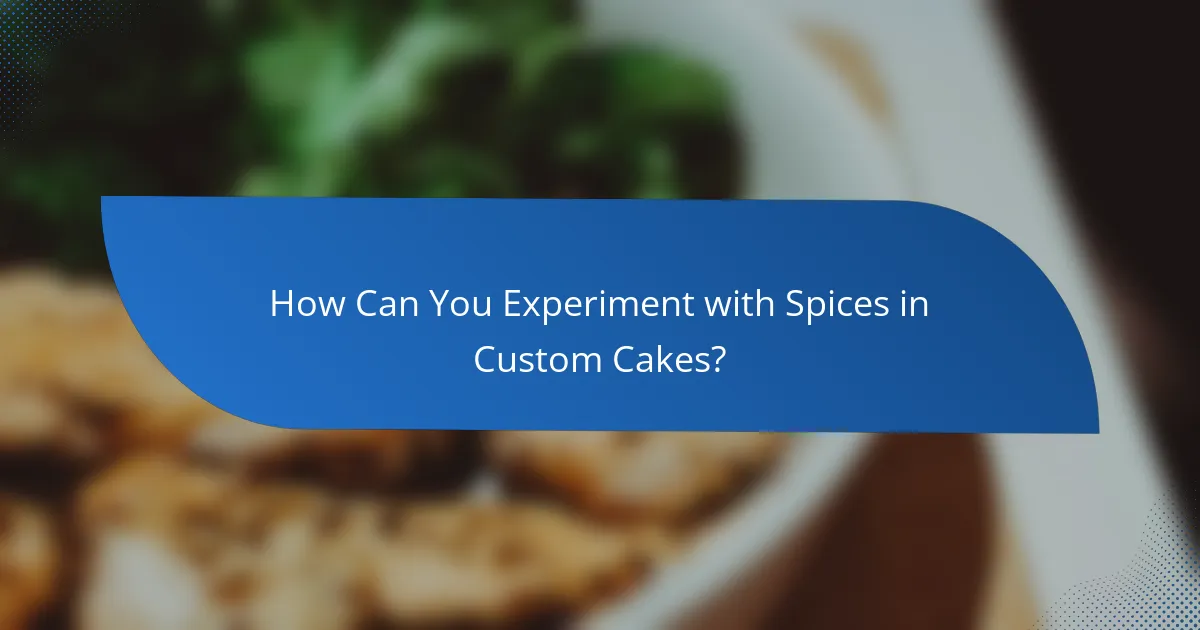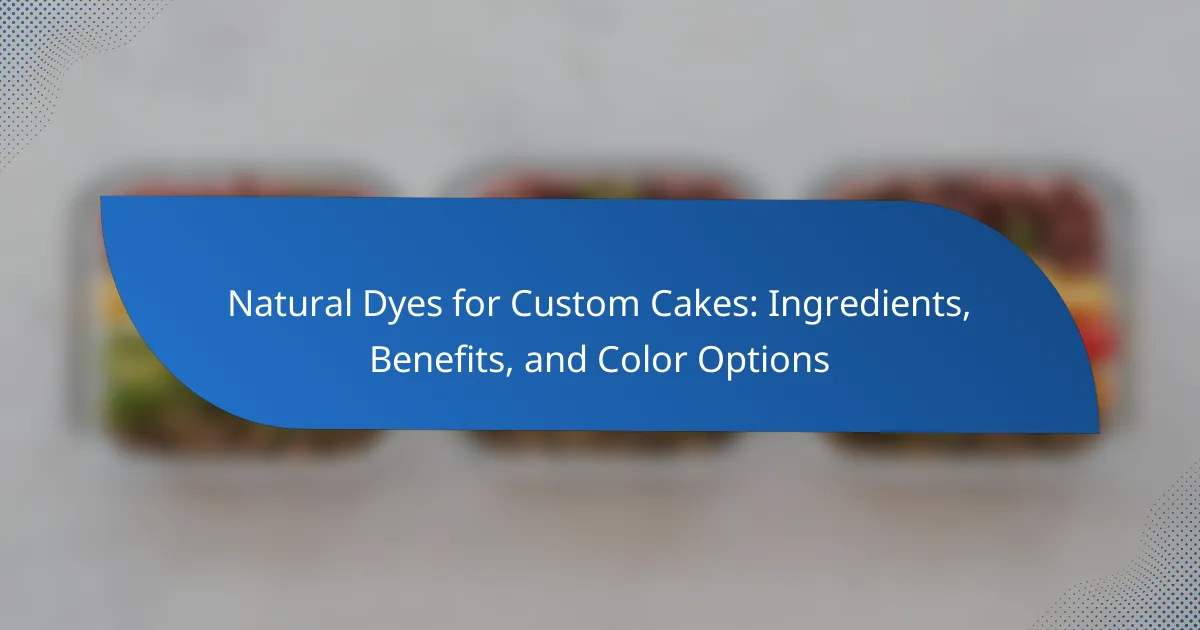Spices are aromatic plant-derived substances that enhance the flavor of food, particularly in custom cakes. Common spices such as cinnamon, nutmeg, ginger, and allspice contribute depth and complexity to cake recipes, while also providing health benefits like anti-inflammatory properties. The article explores the role of spices in cake baking, offering guidance on how to incorporate them effectively into batters and frostings. Techniques for blending spices and their historical significance in baking are also discussed, highlighting the importance of spices in creating unique and memorable custom cakes.

What are Spices and Their Role in Custom Cakes?
Spices are aromatic substances derived from plants, used to enhance flavor in food. In custom cakes, spices play a vital role in adding depth and complexity to the taste profile. Common spices like cinnamon, nutmeg, and vanilla can transform a simple cake into a gourmet experience. They contribute not only flavor but also fragrance, making cakes more appealing. Additionally, spices can offer health benefits, such as anti-inflammatory properties from ginger or antioxidant effects from cloves. The careful selection of spices can elevate the overall quality of custom cakes, making them unique and memorable.
How do spices enhance the flavor of cakes?
Spices enhance the flavor of cakes by adding depth and complexity. They introduce unique taste profiles that can transform a simple cake into a gourmet experience. For example, cinnamon provides warmth and sweetness. Nutmeg adds a nutty and slightly sweet flavor. Cloves contribute a strong, aromatic quality. Ginger offers a zesty kick that can brighten flavors. These spices work synergistically with sugar and fat in the cake batter. The Maillard reaction during baking intensifies these flavors, creating a rich aroma. Studies show that spices can also stimulate the palate, making cakes more enjoyable. Thus, incorporating spices into cake recipes elevates the overall flavor experience.
What specific flavors do different spices contribute?
Cinnamon contributes a warm, sweet flavor. It enhances the sweetness of cakes. Nutmeg adds a nutty and slightly sweet taste. It provides depth to baked goods. Cloves deliver a strong, aromatic flavor. They can create a rich and spicy profile. Ginger offers a sharp, zesty flavor. It adds warmth and a hint of spice. Cardamom provides a sweet and floral taste. It brings a unique complexity to desserts. Allspice combines flavors of cinnamon, nutmeg, and cloves. It adds a well-rounded spiciness to cakes. Vanilla, while not a spice, enhances flavors with its sweet aroma. These spices are commonly used in baking to elevate taste.
How can spices complement various cake types?
Spices enhance the flavor profiles of various cake types. For instance, cinnamon pairs well with apple and carrot cakes. Nutmeg complements pumpkin and spice cakes effectively. Ginger adds warmth to chocolate and molasses cakes. Cloves provide depth in rich fruit cakes. Cardamom brings a unique twist to vanilla and almond cakes. Each spice contributes distinct notes that elevate the overall taste. The right spice can transform a simple cake into a gourmet experience. Studies show that spices can also add health benefits, such as anti-inflammatory properties and antioxidants.
What health benefits can spices provide in cakes?
Spices can provide several health benefits when added to cakes. Cinnamon may help regulate blood sugar levels and has anti-inflammatory properties. Ginger can aid digestion and reduce nausea. Nutmeg has antioxidant properties and may improve sleep quality. Cloves contain eugenol, which has antiseptic and anti-inflammatory effects. Cardamom can enhance oral health and may aid in digestion. These spices not only enhance flavor but also contribute to overall health.
Which spices are known for their health-promoting properties?
Turmeric, ginger, cinnamon, and garlic are spices known for their health-promoting properties. Turmeric contains curcumin, which has anti-inflammatory and antioxidant effects. Ginger is recognized for aiding digestion and reducing nausea. Cinnamon may help regulate blood sugar levels and has anti-inflammatory properties. Garlic is known for boosting the immune system and lowering blood pressure. Each of these spices has been studied for their potential health benefits, making them valuable additions to diets.
How do these health benefits translate to cake consumption?
Health benefits from spices can enhance cake consumption by improving nutritional value. Spices like cinnamon and ginger contain antioxidants that may boost immunity. Incorporating these spices into cakes adds flavor without excessive sugar. For example, cinnamon can help regulate blood sugar levels. Ginger is known for aiding digestion, making the cake easier to enjoy. Additionally, spices can reduce inflammation, promoting overall well-being. Thus, using healthful spices in cake recipes allows for indulgence while supporting health.

What Types of Spices Can Be Used in Custom Cakes?
Common spices used in custom cakes include cinnamon, nutmeg, ginger, and allspice. Cinnamon adds warmth and sweetness, making it popular in many cake recipes. Nutmeg offers a slightly nutty flavor and is often used in holiday cakes. Ginger provides a spicy kick, enhancing flavors in fruit cakes. Allspice combines flavors of cinnamon, nutmeg, and cloves, adding depth to the cake. Other spices like cardamom and cloves can also be used for unique flavor profiles. These spices not only enhance taste but may also offer health benefits, such as anti-inflammatory properties.
What are the most popular spices for baking cakes?
The most popular spices for baking cakes include cinnamon, nutmeg, ginger, and vanilla. Cinnamon adds warmth and sweetness, making it a staple in many cake recipes. Nutmeg provides a rich, aromatic flavor that enhances spiced cakes. Ginger brings a zesty kick, especially in gingerbread and other festive cakes. Vanilla, while technically an extract, is essential for its sweet and creamy aroma, complementing other spices. These spices are widely used due to their ability to elevate the flavor profile of cakes, making them favorites among bakers.
How do these spices differ in flavor profiles?
Different spices have unique flavor profiles that significantly impact culinary applications. For example, cinnamon is sweet and warm, often used in desserts. Nutmeg has a nutty and slightly sweet flavor, adding depth to baked goods. Cloves offer a strong, pungent taste that can enhance both sweet and savory dishes. Ginger is spicy and zesty, providing a refreshing kick in recipes. Allspice combines flavors of cinnamon, nutmeg, and cloves, making it versatile in various dishes. Each spice’s distinct flavor can enhance the overall taste of custom cakes, contributing to their appeal.
What are some unique spices that can be used in cakes?
Unique spices that can be used in cakes include cardamom, nutmeg, and lavender. Cardamom adds a warm, aromatic flavor that enhances sweetness. Nutmeg provides a rich, nutty taste that complements various cake types. Lavender offers a floral note, creating a distinct and refreshing flavor profile. These spices are not commonly used in traditional cake recipes, making them unique choices. Incorporating these spices can elevate the flavor and create a memorable dessert experience.
How can spices be incorporated into cake recipes?
Spices can be incorporated into cake recipes by adding them directly to the batter. Common spices include cinnamon, nutmeg, and ginger. These spices enhance flavor and aroma. For optimal results, use ground spices for even distribution. Typically, one to two teaspoons of spice per cup of flour is recommended. Adjust the amount based on personal taste preferences. Additionally, spices can be infused into liquids like milk or butter before mixing. This method intensifies their flavor. Incorporating spices can also provide health benefits, such as antioxidants from cinnamon.
What are the best practices for adding spices to cake batter?
The best practices for adding spices to cake batter include using the right amount and timing. Start by measuring spices accurately, typically one to two teaspoons for most recipes. Mix spices with dry ingredients to ensure even distribution. This prevents clumping and enhances flavor integration. Add spices early in the mixing process for maximum flavor infusion. Freshly ground spices provide more potency than pre-ground versions. Toasting spices lightly can enhance their aroma and flavor. Consider complementary flavors; for example, cinnamon pairs well with vanilla. Finally, taste the batter before baking to adjust spice levels if necessary.
How much spice should be used for optimal flavor?
For optimal flavor in custom cakes, use spices at a ratio of 1 to 2 teaspoons per cup of flour. This measurement ensures a balanced flavor profile without overpowering the cake. For delicate spices like cinnamon or nutmeg, start with 1 teaspoon. For stronger spices like ginger or cardamom, ½ teaspoon may suffice. Adjust according to personal taste preferences. Research shows that the right spice amount enhances flavor while maintaining cake texture.

How Can You Experiment with Spices in Custom Cakes?
You can experiment with spices in custom cakes by incorporating various spices into the batter or frosting. Start by selecting spices that complement the cake’s flavor profile. Common choices include cinnamon, nutmeg, and ginger. Adjust the quantity based on the spice’s strength and desired flavor intensity. For example, a teaspoon of cinnamon can enhance a vanilla cake.
Mix spices with dry ingredients to ensure even distribution. This technique prevents clumping and ensures a uniform flavor throughout the cake. You can also create spice blends for unique flavor combinations. Consider pairing cardamom with orange zest for a refreshing twist.
Experimenting with spices can elevate the cake’s aroma and taste. Historical baking practices show that spices were used to enhance flavors and preserve baked goods. This tradition continues today, making spice experimentation a valuable technique for custom cakes.
What are some creative combinations of spices for cakes?
Cinnamon and nutmeg create a warm, comforting flavor profile for cakes. This combination is often used in traditional recipes like spice cakes. Ginger and cardamom add a unique zest and complexity to cake flavors. This mix is popular in many Asian-inspired desserts. Cloves and allspice deliver a rich, aromatic quality. These spices are frequently found in holiday baking. Vanilla paired with lavender offers a floral note that elevates cakes. This combination is increasingly popular in gourmet baking. Lastly, cocoa powder with cayenne pepper introduces a surprising kick. This pairing enhances chocolate cakes with depth and intrigue.
How can you balance spice flavors to avoid overpowering the cake?
To balance spice flavors and avoid overpowering the cake, use spices in moderation. Begin with small amounts and gradually increase to taste. Pair strong spices, like cinnamon or clove, with milder ones, such as vanilla or nutmeg. This combination creates a harmonious flavor profile. Additionally, consider the cake’s sweetness; sweeter cakes can handle more spice. Incorporating dairy, like cream cheese or yogurt, can also mellow spice intensity. Taste the batter frequently to ensure balance. Adjusting other ingredients, like sugar or fat, can further help in achieving the desired flavor.
What tips can help in creating signature spice blends for cakes?
To create signature spice blends for cakes, start with a balanced base of warm spices. Common choices include cinnamon, nutmeg, and ginger. Experiment with proportions to find the right flavor profile. Incorporate unique spices like cardamom or allspice for distinctiveness. Consider adding citrus zest for brightness and freshness. Use fresh ground spices for enhanced aroma and potency. Test your blend in small batches before scaling up. Document ratios for consistency in future baking.
What troubleshooting tips exist for using spices in cakes?
To troubleshoot using spices in cakes, ensure the spices are fresh and properly measured. Stale spices can lead to a lack of flavor. Use precise measurements to avoid overpowering the cake. Balance strong spices like cinnamon or nutmeg with complementary flavors. If the spice flavor is too strong, add more cake batter to dilute it. To enhance spice distribution, mix spices with dry ingredients before combining with wet ingredients. Adjust baking time if spices cause the cake to cook unevenly. Finally, taste the batter before baking to gauge spice intensity.
How can you fix a cake that has too much spice flavor?
To fix a cake that has too much spice flavor, you can balance the flavor by adding more cake base ingredients. Increasing the amount of flour, sugar, or fat can dilute the spice intensity. You may also incorporate additional wet ingredients like milk or yogurt to soften the spice flavor. Another option is to add complementary flavors, such as vanilla or citrus zest, to mask the overpowering spices. These methods help create a more balanced taste profile. Adjusting the cake’s texture and flavor components is a common baking technique to address spice imbalances.
What should you do if a cake lacks the desired spice flavor?
Add more spices to the cake batter to enhance the flavor. Common spices include cinnamon, nutmeg, and ginger. Start with small amounts and gradually increase to taste. Mix the spices thoroughly into the batter for even distribution. Additionally, consider using extracts like vanilla or almond for added depth. Adjusting the sugar may also help balance the flavors. Taste the batter before baking to ensure satisfaction. This method is supported by culinary practices that emphasize flavor layering in baking.
Spices are aromatic plant-derived substances that enhance the flavor and aroma of custom cakes while also providing potential health benefits. This article explores the role of various spices, such as cinnamon, nutmeg, ginger, and cloves, in elevating cake flavor profiles and contributing to overall well-being. It details how different spices complement specific cake types, their unique flavor contributions, and best practices for incorporation into recipes. Additionally, the article discusses troubleshooting tips for achieving balanced spice flavors and creative combinations for signature spice blends.



